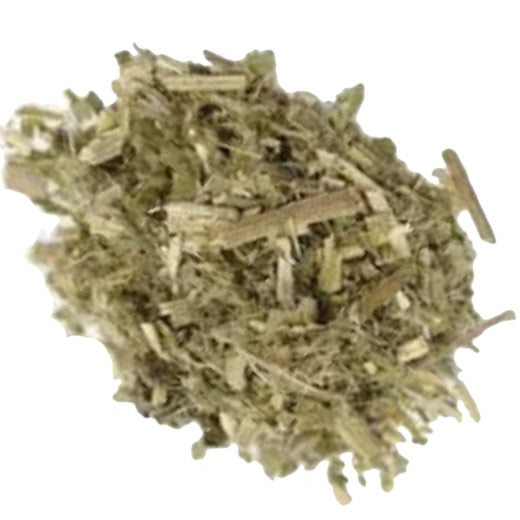Blessed Thistle, Cut & Sifted 1.5 OZ
Blessed Thistle, Cut & Sifted 1.5 OZ
6 in stock
Couldn't load pickup availability
Blessed Thistle (Cnicus benedictus), also known as Holy Thistle or St. Benedict's Thistle, is a herbaceous plant with a long history of traditional use in herbal medicine and folk remedies. Here are some key points about Blessed Thistle:
1. Botanical Description:
- Blessed Thistle is a plant belonging to the Asteraceae family. It has spiny, lobed leaves and produces yellow flowers. The plant is native to the Mediterranean region but has spread to other parts of the world.
2. Historical and Folk Uses:
- Blessed Thistle has a rich history of use in traditional medicine. It was believed to have various health benefits and was used for its purported medicinal properties.
3. Culinary Uses:
- While not a common culinary herb, Blessed Thistle has been historically used in bitter tonics and herbal beverages. It has a bitter taste and was sometimes included in herbal formulations for its potential digestive benefits.
4. Digestive Support:
- Blessed Thistle has been traditionally used to support digestion. It was believed to stimulate the appetite and aid in the digestive process.
5. Galactagogue Properties:
- In traditional herbalism, Blessed Thistle has been associated with galactagogue properties, meaning it was thought to promote the production of breast milk in nursing mothers.
6. Herbal Bitter:
- Blessed Thistle is known for its bitter taste, and bitters have historically been used to stimulate digestive juices and support overall digestive health.
7. Symbolic and Folklore Associations:
- The name "Blessed Thistle" may be derived from its historical use in traditional medicine and its perceived beneficial properties. In folklore, the herb was sometimes associated with protective and purifying qualities.
8. Herbal Preparations:
- Blessed Thistle can be prepared in various ways, including as a tea, tincture, or infusion. These preparations are used to harness the potential health benefits of the herb.
9. Caution and Considerations:
- As with any herbal remedy, it's essential to exercise caution and seek guidance from healthcare professionals, especially if you are pregnant, nursing, or have pre-existing health conditions.
10. Modern Herbalism:
- In contemporary herbalism, Blessed Thistle is still used by some herbal practitioners for its potential digestive and galactagogue properties. It may be found as an ingredient in certain herbal blends or supplements.
11. Magical and Ritual Uses:
- In some magical traditions, herbs like Blessed Thistle are associated with protective and purifying energies. It may be used in rituals, spellwork, or charms for these purposes.
When considering the use of Blessed Thistle:
- Consultation with Healthcare Professionals: Before incorporating Blessed Thistle or any herbal remedy into your routine, especially if you have health concerns or are taking medications, consult with a qualified healthcare professional.
- Magical Intentions: If using Blessed Thistle in magical practices, set clear intentions and understand the symbolic associations within your specific magical or spiritual tradition.
Always approach the use of herbs with respect, awareness, and a well-informed perspective. Each individual may respond differently to herbal remedies, and it's important to make choices that align with your health, beliefs, and personal circumstances.
In Wicca and various pagan or magical traditions, herbs like Blessed Thistle are often used in rituals, spells, and magical workings for their perceived energetic properties and symbolic associations. Here are some potential uses of Blessed Thistle in a Wiccan or magical context:
1. Purification and Cleansing:
- Blessed Thistle is believed by some practitioners to have purifying and cleansing properties. It may be used in rituals to cleanse an area or as part of a purification spell.
2. Protection:
- Some individuals associate Blessed Thistle with protective energies. It might be used in spells or rituals aimed at creating a protective barrier or warding off negative influences.
3. Spiritual Clarity:
- Blessed Thistle is thought by some to enhance spiritual clarity and insight. It may be used in rituals or spells when seeking clarity in matters of spirituality or divination.
4. Offerings:
- In certain Wiccan rituals or ceremonies, practitioners may offer herbs like Blessed Thistle as gifts to deities, spirits, or the elements. This can be a way to show gratitude and seek blessings.
5. Strength and Vitality:
- Blessed Thistle is associated with strength and vitality in some magical traditions. It might be included in spells or rituals aimed at increasing personal strength or overcoming challenges.
6. Connection to the Divine Feminine:
- Some practitioners associate Blessed Thistle with the divine feminine energy. It may be used in rituals honoring goddesses or during ceremonies that celebrate feminine aspects of spirituality.
7. Herb Sachets and Amulets:
- Blessed Thistle can be included in herb sachets or amulets for magical purposes. These small pouches can be carried or placed in specific locations to attract or repel certain energies.
8. Ritual Baths:
- Adding Blessed Thistle to ritual baths is believed by some to enhance the spiritual and magical properties of the bath. This can be a way to cleanse and consecrate oneself before ritual work.
9. Magical Intentions:
- As with any magical herb, the effectiveness often depends on the practitioner's intent and personal connection to the plant. Clearly set your intentions before using Blessed Thistle in any ritual or spell.
Remember that magical practices can vary among individuals and traditions. It's important to study the specific correspondences and associations of Blessed Thistle within the context of your own Wiccan or magical tradition. Additionally, consider consulting with experienced practitioners or trusted sources to deepen your understanding of the magical properties of herbs. Always approach magical workings with respect, mindfulness, and a sense of personal responsibility.
Share

Guaranteed Safe Checkout

